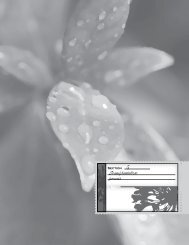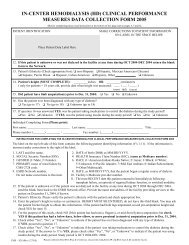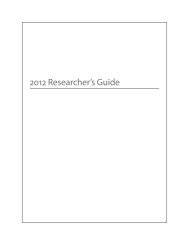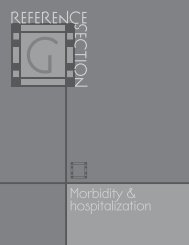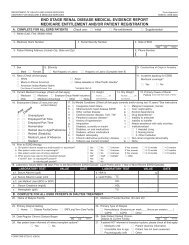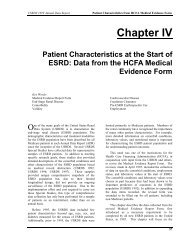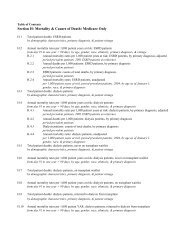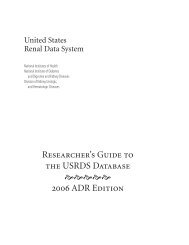2009 ADR v2 Atlas of ESRD - United States Renal Data System
2009 ADR v2 Atlas of ESRD - United States Renal Data System
2009 ADR v2 Atlas of ESRD - United States Renal Data System
You also want an ePaper? Increase the reach of your titles
YUMPU automatically turns print PDFs into web optimized ePapers that Google loves.
5<br />
App A<br />
pg 380<br />
code for inclusion in the analysis (these codes are identified with an<br />
asterisk in Table a.b). PPPY total vascular access costs (Figure 11.18)<br />
are obtained from event-based analyses, and include both physician/supplier<br />
costs as described above, and facility costs that can<br />
be attributed to vascular access services. Facility costs are difficult<br />
to identify. For inpatient facility costs, vascular access procedures<br />
in the inpatient setting (identified from the physician/supplier SAF)<br />
are matched with inpatient claims, and all procedures performed<br />
during a given inpatient stay (admission date through discharge<br />
date) are considered a single vascular access event. Because vascular<br />
access procedures are <strong>of</strong>ten performed when a patient is hospitalized<br />
for another reason, costs for inpatient facilities are included in<br />
the analysis only if the cause <strong>of</strong> hospitalization can be reasonably<br />
attributed to vascular access, using Diagnosis Related Grouping<br />
(DRG) and ICD-9-CM principal procedure codes, or ICD-9-CM principal<br />
diagnosis codes (Table a.c). Such hospitalizations are labeled<br />
“pure” inpatient vascular access events.<br />
For outpatient facility costs, physician/supplier claims with<br />
vascular access procedures performed in the outpatient setting<br />
are linked to outpatient claims, using service dates and CPT codes.<br />
These costs are included in the analysis only if a matching CPT code<br />
is found on both physician/supplier and outpatient claims. Once<br />
again, all procedures and costs for the entire matching outpatient<br />
claim are considered part <strong>of</strong> a single vascular access event. Since<br />
the CPT code is not a required element on outpatient claims, not<br />
all outpatient facility costs for vascular access can be identified.<br />
Events that can be identified in the outpatient claims are labeled<br />
“pure” outpatient vascular access events.<br />
Although vascular access procedures can be identified from<br />
claims data, it is not possible to determine with certainty the type<br />
<strong>of</strong> vascular access being used for dialysis at any given time. In order<br />
to compare overall and vascular access costs by type <strong>of</strong> vascular<br />
access, data are analyzed for the hemodialysis cohort from the CMS<br />
<strong>ESRD</strong> Clinical Performance Measures Project (CPM) for 1999 through<br />
2007. The CPM project collects data annually on a random sample<br />
<strong>of</strong> hemodialysis and peritoneal dialysis patients, including the type<br />
<strong>of</strong> vascular access being used for hemodialysis at the time <strong>of</strong> data<br />
collection. The CPM data for hemodialysis patients are collected<br />
from October through December <strong>of</strong> the year prior to the cohort<br />
a bii<br />
CPT codes for vascular access &<br />
peritoneal dialysis access services<br />
Complication 34101 * , 35190 * , 35321 * , 35458 * ,<br />
35460 * , 35475 * , 35476 * , 35484 * , 35875 * , 35876 * ,<br />
35900 * , 35903 * , 35910 * , 36005 * , 36145, 36534 * ,<br />
36535 * , 36550 * , 36575 * , 36580 * , 36581 * , 36584 * ,<br />
36589 * ,36596 * , 36597 * , 36831, 36832, 36833,<br />
36834 * , 36838, 36860, 36861, 36870, 37190 * ,<br />
37201 * , 37205 * , 37206 * , 37207 * , 37208 * , 37607,<br />
49422, 75790, 75820 * , 75860 * , 75896 * , 75960 * ,<br />
75962 * , 75978 * , 76937 * , 75998 * , 00532 * , 01784 * ,<br />
01844 * , 90939, 90940, G0159, and M0900<br />
Hemodialysis catheter placement 36011 * ,<br />
36488 * , 36489 * , 36490 * , 36491 * , 36533 * , 36555 * ,<br />
36556 * , 36557 * , 36558 * , 36565 * , and 36800<br />
Peritoneal dialysis catheter placement 49419,<br />
49420, and 49421<br />
Synthetic graft placement 36830<br />
Fistula placement 36818, 36819, 36820, 36821,<br />
and 36825<br />
* Requires accompanying renal<br />
diagnosis code for inclusion.<br />
a cii<br />
year (e.g., CPM data were collected from October through December,<br />
2006, for the 2007 cohort). For Figures 11.17–18 we classify patients<br />
by the vascular access in use at the time <strong>of</strong> the CPM data collection,<br />
and aggregate costs for the following calendar year, with followup<br />
until the earliest <strong>of</strong> death, transplant, modality change, or the<br />
end <strong>of</strong> the calendar year. This analysis is limited to patients with<br />
Medicare as primary payor.<br />
For Figure 11.20, prevalent hemodialysis patients from 1998–2006<br />
are matched to the <strong>ESRD</strong> CPM data to obtain the vascular access in<br />
use at the end <strong>of</strong> their prevalent year. Inpatient hospital stays during<br />
the following calendar year (censored at a change in modality<br />
or a placement event for a different type <strong>of</strong> access) are identified as<br />
being for a vascular access infection if the principal diagnosis is<br />
996.62, “Infection <strong>of</strong> Internal Device.” The total payment amount<br />
from that inpatient stay is used to calculate a PPPY cost.<br />
Information about the construction <strong>of</strong> other figures and tables<br />
is provided in the captions.<br />
REFERENCE SECTION K: MEDICARE CLAIMS DATA<br />
Cost information in this section is derived from Medicare inpatient/<br />
outpatient and physician/supplier claims data in the CMS Standard<br />
Analytic Files, which are created annually six months after the end<br />
<strong>of</strong> each calendar year. The data for 2003–2007 are comprised <strong>of</strong><br />
approximately 41 million institutional claims for hospital inpatient<br />
and outpatient facilities, outpatient dialysis facilities, skilled nursing<br />
facilities, hospice facilities, and home health agencies, as well as<br />
over 350 million line items from physician/supplier claims. Claims<br />
data are obtained for all patient identification numbers in the USRDS<br />
database, and the <strong>Renal</strong> Management Information <strong>System</strong> (REMIS)<br />
is used to gather all CMS ID numbers under which patients may have<br />
claims. The claims data are then merged with patient demographic<br />
data and modality information in the USRDS database.<br />
The economic analyses for this section focus on two amounts<br />
found in the claims data: the claim payment amount, which is the<br />
amount <strong>of</strong> the payment made from the Medicare trust fund for<br />
the services covered by the claim record; and the pass-through per<br />
diem amount, which applies to inpatient claims and reimburses the<br />
provider for capital-related costs, direct medical education costs,<br />
and kidney acquisition costs.<br />
DRG & ICD-9-CM codes for vascular access<br />
& peritoneal dialysis access services<br />
DRG codes a<br />
112 Percutaneous cardiovascular procedure 120 Other circulatory system OR procedure<br />
315 Other kidney and urinary tract OR procedure 442 Other OR procedure for injuries with<br />
complication 443 Other OR procedure for injuries without complication 478 Other vascular<br />
procedure with complication 479 Other vascular procedure without complication<br />
ICD-9-CM procedure codes a<br />
38.95 Venous catheterization for renal dialysis 39.27 Arteriovenostomy for renal dialysis<br />
39.42 Revision <strong>of</strong> arteriovenous shunt for renal dialysis 39.43 Removal <strong>of</strong> arteriovenous<br />
shunt for renal dialysis 39.93 Placement <strong>of</strong> vessel-to-vessel cannula 39.94 Replacement <strong>of</strong><br />
vessel-to-vessel cannula 86.07 Placement <strong>of</strong> totally implantable vascular access device<br />
ICD-9-CM diagnosis codes b<br />
996.1 Mechanical complication <strong>of</strong> vascular device, implant, graft 996.56 Mechanical<br />
complication due to peritoneal dialysis catheter 996.62 Infectious complication <strong>of</strong> vascular<br />
device, implant, graft 996.68 Infectious complication due to peritoneal dialysis catheter<br />
996.73 Other complication due to renal dialysis device, implant, graft V56.1 Fitting and<br />
adjustment <strong>of</strong> extracorporeal dialysis catheter V56.2 Fitting and adjustment <strong>of</strong> peritoneal<br />
dialysis catheter<br />
a DRG and procedure codes are used in conjunction to define inpatient pure vascular access events (both must<br />
be present)<br />
b the presence <strong>of</strong> any <strong>of</strong> these diagnosis codes as the “Principal Diagnosis Code” is sufficient to define an<br />
inpatient pure vascular access or peritoneal dialysis access event



